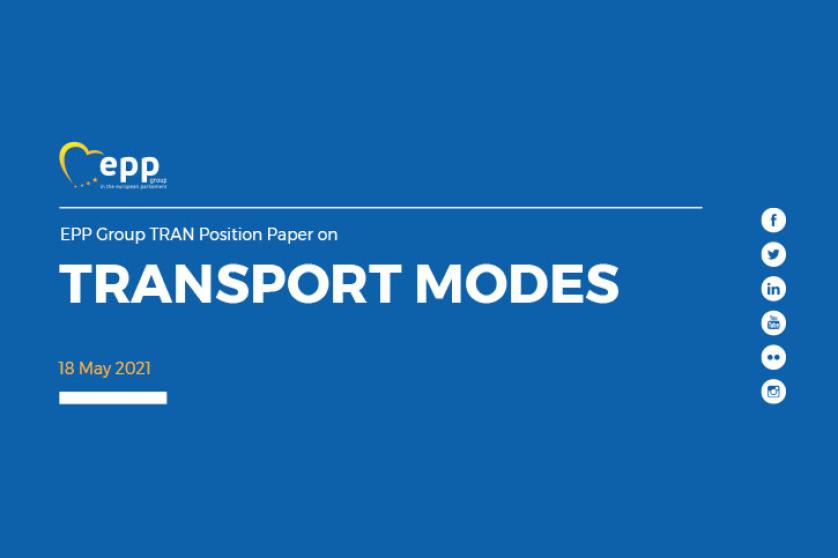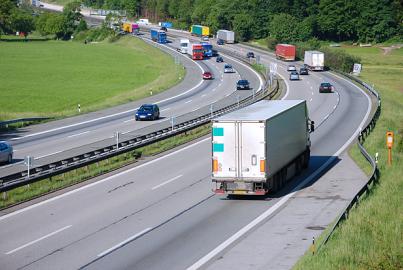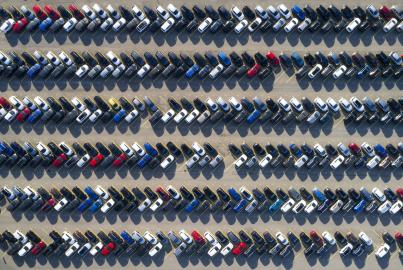EPP Group TRAN Position Paper on Transport Modes

1. Automotive sector
With the adaptation towards digital and climate-friendly mobility, the automotive sector is facing one of the greatest transitions in its history. The EPP Group believes that it is the task of European legislators to help the sector achieve climate-neutrality in a realistic, technology-neutral and socially responsible manner.
We believe that a holistic and science-based approach is needed. All future measures should stem from the results of comprehensive impact assessments that take into account economic, environmental and social consequences as well as the diverse mobility needs of users. The environmental performance should be determined by measuring life-cycle emissions. Technological neutrality, impact awareness and legislative predictability need to be guiding principles for all legislative work still to come.
The EPP Group is convinced that mobility is a right for all EU citizens. We need a clear, honest and realistic commitment to the future of individual mobility and we need to ensure that it does not become a luxury for a few. There is no one-size-fits-all solution. Blanket prohibitions of internal combustion engines (ICEs) are not in the best interest of European citizens and our employers. Users should decide which technology they deem best to serve their needs.
We believe in the innovative abilities and potential of the automotive industry. This innovative power needs to be backed and stimulated by sufficient funding capacities for research and development through EU funds. NextGenerationEU is Europe’s chance to provide funding for the development of even more efficient ICE vehicles, more affordable Low and Zero Emission Vehicles and the deployment of alternative fuels.
We stress the necessity of recyclability and call for a dedicated European program for recycling vehicles. This could be brought about through the EU Circular Economy legislation.
An ambitious approach on infrastructure is indispensable. Enabling the deployment of adequate digital network infrastructure, an efficient and dense network of charging points and re-fuelling stations for passenger cars and commercial vehicles, including in insular and outermost regions and rural areas, secured freight parking areas and enough sanitary units should be the priority for European legislators in the next years. We expect an ambitious revision for the TEN-T, focusing on the completion of the core network and the elimination of cross-border bottlenecks by 2030.
The revision of the Alternative Fuel Infrastructure Directive provides the opportunity to set ambitious mandatory targets for the use of alternative fuels. Together with requirements for interoperability, common standards and a single payment system, a truly common charging space can be created. Alternative fuels such as hydrogen are a tool at hand to lower emissions of the existing fleet, especially for heavy-duty vehicles. The revision of the Energy Performance of Buildings Directive should support the deployment of charging and refuelling infrastructure in private and public, existing and new buildings.
Large-scale electrification of vehicles will only be possible with access to efficient, priceworthy and climate friendly battery technologies. Today the vast majority of vehicle batteries are produced outside Europe, and a rise in development and production capacity of batteries in the EU will be crucial for the short-term survival and the long-term prosperity of European auto manufacturers. The EU must therefore incentivise research and development in this field, in close cooperation between industry and academia, increase funding for such development and facilitate the production of batteries for European vehicles and for export abroad.
The transition in the automotive sector needs to be supported by an EU-wide expansion of renewable energy sources, including a program to ensure competitive and affordable prices for electricity. An ambitious revision of Renewable Energy Directive II and the national implementations should support the deployment of hydrogen and e-fuels infrastructure.
Only if we ensure that adequate infrastructure exists in the short-term, can we credibly talk about significantly speeding up emission cutting in the sector and achieving climate targets. Setting new emission reduction targets should be based on scientific facts and comprehensive impact assessments and also look at other paths for emission reductions such as increasing the overall system efficiency.
Infrastructure investments should be supported by coordinated incentive schemes for passenger and commercial vehicles by the Member States and a European awareness campaign to illustrate the benefits for different types of ZLEV. The long-term inclusion of road transport into the EU ETS system can be a complementing tool and should be considered if warranted by an impact assessment.
The EPP Group supports all efforts to improve road safety and in achieving the aims of Vision Zero. Safety must always be our utmost objective when designing infrastructure. Revenues from taxes, tolls, vignettes or fuel duties paid by road users should be reinvested in their entirety in the upkeep, modernisation and improvement of our road infrastructure, including measures to offset negative consequences for people living in proximity to heavy traffic.
The transition in the automotive sector will inevitably lead to job losses. New production chains should be regarded as key technologies and need to be at the heart of an EU Industrial Policy. Increased European financial support for re-skilling and skills upgrading is necessary, in particular in countries and regions with strong automotive industrial bases. The Commission should consider reforming EU State Aid rules in order to allow for more focused support through the Member States.
The Covid-19 pandemic has negatively affected the investment and funding capacities of Member States and purchase decisions by consumers will be postponed. Existing legislation should undergo a review, in particularly focusing on SMEs, and unnecessary red tape needs to be cut in order to reduce burdens, both administrative and financial. We should enable the automotive sector to turn the downturn into an opportunity to ensure long-term prosperity and jobs.
Legislation required:
- Broad policy areas where the Commission is yet to propose new binding legislation (Partially proposed, Communications and INIs or nothing):
- EU Road Safety Policy Framework 2021-2030 - Next steps towards "Vision Zero"
- State aid rules revision also in the aftermath of Covid-19
- Circular Economy
In the Pipeline:
- Revision of the EU Emissions Trading System (ETS), including maritime, aviation and CORSIA as well as a proposal for ETS as own resource (legislative, incl. impact assessment, Q2 2021)
- Amendment to the Renewable Energy Directive to implement the ambition of the new 2030 climate target (legislative, incl. impact assessment, Article 194 TFEU, Q2 2021)
- Amendment of the Energy Efficiency Directive to implement the ambition of the new 2030 climate target (legislative, incl. impact assessment, Article 194 TFEU, Q2 2021)
- Revision of the Directive on deployment of alternative fuels infrastructure (legislative, incl. impact assessment, Article 91 TFEU, Q2 2021)
- Revision of the Regulation setting CO2 emission performance standards for new passenger cars and for new light commercial vehicles (legislative, incl. impact assessment, Article 192(1) TFEU, Q2 2021)
- Revision of the Directive on Intelligent Transport Systems, including a multimodal ticketing initiative (legislative, incl. impact assessment, Article 91 TFEU, Q3 2021)
- Development of post-Euro 6/VI emission standards for cars, vans, lorries and buses (legislative, incl. impact assessment, Article 114 TFEU, Q4 2021)
- Updating the new Industrial Strategy for Europe (non-legislative, Q2 2021)
Refit:
- Revision of the Energy and Environmental Aid Guidelines - Planned adoption date: Q4/2021; non-legislative; Legal basis: Articles 107 and 108 of the TFEU. Impact assessment is envisaged.
Priority legislation:
- Proposal for a REGULATION OF THE EUROPEAN PARLIAMENT AND OF THE COUNCIL amending Regulation (EC) No 715/2007 on type approval of motor vehicles with respect to emissions from light passenger and commercial vehicles (Euro 5 and Euro 6) and on access to vehicle repair and maintenance information
2. Aviation
Aviation should adapt more to the new requirements, greening and digitalisation, without damaging the benefit of this mode of transport as connectivity, mobility, affordable prices and preserving safety and security of the services. We have to provide the decrease of emissions not of the traffic. Passengers’ benefits should not be touched by the transition process.
Aviation is based on high technology. The technological progress of reduction of emissions was not very visible because of the traffic increase.
There are few directions to follow in order to reach the 2030 targets and the 2050 goal: modernisation and reforming of Air Traffic Management System, investing in R&I for new technological solutions regarding Sustainable Aviation Fuels, engines, other propulsion systems, such as electrical, hybrid or hydrogen and global reduction systems.
Further emissions reduction may be achieved with the adoption and implementation of the legislation on the Single European Sky 2+. The Commission proposal could be improved but should not be diluted by the attempts of the Member States to keep the actual monopoly based on outdated arguments, such as sovereignty. The use of satellites systems for navigation, communications and tracking, and the complete deployment of the Single European Sky Air Traffic Management Research (SESAR) will contribute to the completion of the European Digital Single Sky.
The 2021-2027 proposals for the European Partnerships as SESAR or Clean Aviation and CEF with a focus on 2021- 2023 are crucial for the future of aviation digitalisation and should provide for appropriate financing and results, proved by demonstrators.
Sustainable Aviation Fuels need to increase their market share in order to contribute to emissions reduction. ReFuelEUAviation-Sustainable Aviation Fuels should provide for a thorough assessment of the lifecycle emission of these fuels, for a balanced use of raw materials, for a clear path of implementation, a blending mandate minimum of 10% until 2030 and for incentives, including sources to boost both production and utilisation. This mandate should apply at least at the EU level on all flights arriving to and departing from EU. Clean Aviation JU should continue and intensify to provide 34 technological solutions, including for alternative fuels.
The engine manufacturing applied in the last number of years in new technologies allows important emissions reduction. R&D in this respect should continue, including in Clean Sky JU. The implementation of the new products should be promoted through retrofitting and renewal schemes. The Commission should include financing solutions, as for example RRF, in the exploration of the benefit of these schemes. Electric or hydrogen propulsion solutions are suitable for small and medium sized planes that could be used for European short-range or flight duration, single-leg flights. A revision of state aid rules for airports could help in developing short distance connections in order to significantly decrease emissions and travel time, while increasing efficiency.
Airports should be systematically connected to cities through high capacity train lines. Airports must use only zero-emissions vehicles. The revision of Airport Charges Directive should take in account these requirements.
Aviation needs to advance the deployment and ensure ambition in the international carbon-offsetting scheme, known as CORSIA. To achieve this, the Union must speak with one voice in the International Civil Aviation Organisation (ICAO). Revision of the European Emissions Trading Scheme (ETS) should be based on a comprehensive assessment and should provide for a parallel implementation with 54 CORSIA, including, if possible, faster benchmarks as those decided by ICAO.
Legislation required:
In progress:
- Single European Sky 2+ recast
- EASA-Performance Review Body
In the Pipeline:
- Revision of the EU Emissions Trading System (ETS), including maritime, aviation and CORSIA as well as a proposal for ETS as own resource (legislative, incl. impact assessment, Q2 2021)
- Revision of the Directive on deployment of alternative fuels infrastructure (legislative, incl. impact assessment, Article 91 TFEU, Q2 2021)
- Action plan on synergies between civil, defence and space industries (non-legislative, Q1 2021)
Refit:
- a) Revision of Regional Aid Guidelines - Planned adoption date: Q1/2021; non-legislative, Legal basis: Articles 107 and 108 of the TFEU. No impact assessment is envisaged.
b) Revision of State Aid in aviation (requested by industry - not yet planned)
- Revision - Computer reservation systems - Planned adoption: Q4/2021; Legislative; Legal basis: Articles and 100(2) of the TFEU. Impact assessment is envisaged.
- Evaluation of three passenger rights Regulations on: the rights of persons with disabilities and persons with reduced mobility when travelling by air (Regulations No 1107/2006), the rights of passengers when travelling by sea and inland waterway and (Regulation (EU) No 1177/2010), and the rights of passengers in bus and coach transport (Regulation (EU) No 181/2011) - TBC
Priorities pending:
- Proposal for a REGULATION OF THE EUROPEAN PARLIAMENT AND OF THE COUNCIL amending Regulation (EC) No 261/2004 establishing common rules on compensation and assistance to passengers in the event of denied boarding and of cancellation or long delay of flights and Regulation (EC) No 2027/97 on air carrier liability in respect of the carriage of passengers and their baggage by air (considered a priority by COMM, but not yet unblocked)
- Proposal for a REGULATION OF THE EUROPEAN PARLIAMENT AND OF THE COUNCIL on common rules for the allocation of slots at European Union airports (considered a priority by COMM, but not yet unblocked).
3. Inland Waterways
The further development of the inland waterway sector is a cornerstone to building a smart, sustainable and competitive European transport network. SMEs and family businesses are the backbone of the sector. As one of the most environmentally-friendly modes of transport and its largely untapped potential of transporting large amounts of goods across the Union, inland waterways can play a fundamental role in meeting the EU’s climate objectives. A current modal share of 6% is far too little: a sharp increase in the modal share of inland waterway transport would lead to less road congestion, enhanced safety, less emissions and a more sustainable transport system as a whole.
The EPP Group therefore calls for a holistic approach towards this entire mode of transport: increase its resilience, efficiency and sustainability, promote and incentivise its usage and allow for sufficient investments. With such an approach, we can strengthen the sector’s competitiveness, safeguard quality jobs, and boost its readiness for the future European economy.
Improving physical infrastructure and navigation
Contrary to many congested roads, European waterways dispose of free capacity, offering a significant modal shift potential. Yet, the navigability of European inland waterways is patchy and the modal shift is hindered by missing links and poor reliability of free-flowing inland waterways. For the TEN-T review, focus should be on completing the TEN-T core inland waterway network by 2030, eliminating the missing links and allowing for quality physical and digital infrastructure such as improved rail links at ports. The EPP Group calls on the European Commission to present proposals for a regulatory framework in line with the next NAIADES action programme, providing European harmonisation and standardisation for both quality navigability and equipment. Dedicated financing directed towards fit-for-future waterways infrastructure and shipping needs to be set up across all funding instruments, such as the Connecting Europe Facility, the Cohesion Funds, or with the participation of the European Investment Bank. In particular, the Recovery and Resilience Facility (RRF) must be seized upon as a unique funding opportunity for inland waterways, combining short-term economic recovery effects with the long-term benefits of targeted infrastructure investments. These investments could include the rehabilitation of connecting waterways and canals to open up further market potentials.
A realistic sustainable transition
Due to the current lack of market ready zero-emission technologies, the EPP Group calls on the Commission to develop a realistic roadmap to further reduce the pollutants and GHG emissions in order to reach a decarbonised inland waterway sector by 2050, while safeguarding competitiveness, reliability and safety. For the revision of the Alternative Fuels Infrastructure Directive (AFID) and the review of the recast Renewable Energy Directive (RED II), the EPP Group supports a technology neutral and network approach to the availability and roll out of alternative fuels and infrastructure on the waterway network. Inland waterway transport can be suitable for the deployment of hydrogen, LNG, sustainable fuels, hybrid and electric vessels, when the EU directs adequate research funding this way as well as incentivises its usage and improves the scalability of required investments. The inland waterways infrastructure must be better integrated into the European energy grid, to facilitate both the use of on-shore power supply and the potential of inland waterways for the transport of alternative fuels. At the same time, the EPP Group welcomes the use of all readily deployable options to reduce inland navigation emissions, including bridging fuels and transitional systems such as improved catalysts and filters for existing ships. With around 80% of vessels operating on European inland waterways being built in the 20th century, we want to offer the sector the best opportunities for the upcoming fleet renewal: Regulatory stability and financial support are key for deploying both affordable and cleaner vessels on Europe’s rivers and canals. This is why we ask for retrofitting and fleet renewal schemes for Inland Waterway Transport and the granting of tax incentives by Member States to facilitate the transition of the sector.
Accelerating the digital transition
Digitalisation and automation will offer major possibilities for inland waterway transport. Digital exchanges of data and automated processes will contribute to optimise traffic flows and capacity management, making the sector increasingly efficient, safe and sustainable. They also have the potential to address congestion problem in ports, allowing for an efficient handling of goods and improved logistics on the basis of a good connection between maritime and inland navigation. The EPP Group calls for a strategy to develop and deploy digital technologies in the inland waterway sector, outlining both interoperable standards across modes and borders as well as the required research actions and funding, including via dedicated calls within Horizon Europe. Standards from the European Committee for drawing up standards in the field of inland navigation (CESNI) and standards from the River Information Services (RIS) Directive should be updated to ensure interoperability with other modes and allow for the speedy development and deployment of innovative solutions. The transition towards a digitalised and automated sector also highlights the importance of having adequate training and education in place for the workforce, ensuring that inland waterways can be an attractive workplace with high social, qualification, and safety standards.
European multimodal transport
As EU multimodal transport has been slow to develop, we call for the creation of a European multimodal transport network that optimises the interplay between the different transport modes. In cooperation with stakeholders, the EU should provide measures to remove the legislative, administrative, and cross-border obstacles that hamper multimodal transport within the European economy. Such multimodal vision should be elaborated upon in the next NAIADES action programme. Furthermore, incentives should be provided for the development of intermodal ports platforms. The EPP Group calls for the launch of a Project of European Added Value, financed by the RRF, for the navigability and multimodal connection of TEN-T inland waterways corridors.
4. Maritime sector
The EPP Group is fully committed to strengthening Europe’s maritime transport and making it fit for the future. European maritime transport is already the most energy efficient and environmentally performant mode of transport based on its emissions per tonne of goods transported and per kilometre travelled, but more can be achieved to increase its efficiency and sustainability while safeguarding its international competitiveness and its crucial role for generating jobs and growth. These are our guiding principles for the upcoming revisions of maritime transport related EU legislation:
- For the ETS revision: any potential inclusion of maritime transport in the EU ETS should be duly justified and based on an in-depth impact assessment, taking into account the competitiveness of EU operators and businesses, employment in the maritime sector, and the risk of carbon leakage. Due to the international dimension of maritime transport, the most optimal market-based measure for the reduction of greenhouse gases from maritime transport would be an IMO mechanism. At global level, the EU must also use its weight in the IMO to achieve a carbon-offsetting scheme in international shipping to ensure a realistic path of emissions reduction. In parallel, we ask for a clear strategy for the EU maritime sector, including benchmarks for reducing emissions.
- We are currently observing a very dynamic development of alternative fuels for ships. The future legislative proposal FuelEU maritime should be made available as soon as possible and should provide for technological neutrality, progressively increased blending mandates, roadmaps for supplying and charging points, and a clear commitment to transitional fuels such as LNG.
- The zero-emissions target for ports is very ambitious but difficult to achieve in the short term. It requires a holistic view of port activities, which includes emissions related to shipping and other transport modes as well as industrial activities. Therefore, the primary objective should be to reduce emissions in ports closest to urban areas where the environmental aspect is particularly important for public health. It is necessary to assess how much of the limited public funding should be allocated to investments in onshore power supply (OPS) for ships at berth, taking into account a potential increase in the number of vessels using low-carbon and zero-carbon fuels, making the use of OPS redundant.
- Adequate transition periods should be provided for the introduction of further environmental requirements to allow the best use of limited resources. The reduction of greenhouse gas and air pollutant emissions requires appropriate financial support at EU and Member State level in order to enable large-scale investments in research, technology and infrastructure. With this view, the Commission and the industry should assess the creation of a European Partnership for Maritime Transportto foster innovation within the sector.
- For the TEN-T revision, it is of paramount importance to improve the connection of TEN-T ports with railway lines, roads and, where possible, inland waterways. The maritime pillar of the TEN-T, i.e. Motorways of the Sea, requires further support, simplification and adequate funding in order to achieve a European Maritime Transport Space without barriers.
- Emphasises must be placed on the maritime sector’s crucial role in maintaining Europe’s role in world trade and its potential to boost European competitiveness. Therefore, more EU funding must be reallocated to improve accessibility to TEN-T core ports for the largest ships with capacity to replace several smaller ones, improving transport efficiency, reducing costs and cutting emissions. This requires investment in continuous dredging, channel deepening and other capacity-building measures in selected core ports.
- For the review of the recast Renewable Energy Directive and the Alternative Fuels Infrastructure Directive, offshore renewable energy has the potential to become a core component of Europe’s energy system by 2050. This will require investments in port infrastructure in order to facilitate servicing of the offshore industry.
- For the completion of the EU legal framework on the approval of automated vehicles, due to the increasing use of data and artificial intelligence in the maritime transport, it is expected that, in the near future, the first fully autonomous vessels will start operating in European waters. It is therefore becoming essential to prepare the relevant regulations as well as to carry out analyses of the socio-economic impact of automation and digitalisation on the sector.
5. Rail Freight
The EPP Group is fully committed to achieving positive growth in rail freight over the next years in order to meet 30% modal share by 2030. Our EPP Group safeguard for the achievement of this goal: The transport costs for citizens and companies shall not rise, with the cost per tonne-kilometre (t/km) in road transport being our benchmark. Our EPP Group way to success is the improvement of the existing regulatory framework, legal organisation as well as the reduction of technological and operational barriers.
This is our legislative roadmap for rail freight transport:
- Complete Infrastructure: Complete ERTMS equipment has to be achieved until 2030 as a matter of urgency. Since this process is ongoing for more than 20 years already, Member States need to explain the delay, while immediately putting forward national plans. TEN-T core network construction has to be completed until 2030, including terminals for the last mile. We will insist on these points in the review of the TEN-T regulation. The corresponding need for massive investments should be met through targeted RRF implementation and national recovery instruments with a strong focus on rail freight infrastructure investments;
- Ensure healthy competition within rail freight: A level playing field between freight divisions of incumbents and new entrants must be created and equal access to infrastructure ensured. Track access charges must be reviewed, especially where costs are covered by PSOs, as this can be misused to limit competition and diminish rail’s competitiveness with road. Based on these guiding principles we request a revision of the Rail Freight Corridors Regulation, a review of the Combined Transport Directive and revised rules for capacity allocation and infrastructure charging, via a review of the Land PSO Regulation. The 4th Railway Package has to be fully implemented in this regard;
- Improve organisation of the sector: European train path categories and hierarchies1 must be introduced until 2025. A European Infrastructure Manager unit must be established within ERA for slot allocation and capacity management until 2025. This can be foreseen in the revision of the Rail Freight Corridors Regulation in order to ensure that the capacity allocation for rail freight meets the demand along the TEN-T. A common operating language for rail, as it is in aviation, must be introduced until 2025, for example via a revision of the Directive on the certification of train drivers;
- Roll out of Digitalisation: Open and transparent digital platforms to exchange data have to be introduced until 2025. This can be achieved with a review of the regulatory framework for interoperable data sharing in rail transport and new rules for a trusted environment for corridor data exchange to support collaborative logistics. Digital Management of network capacity, digital booking of slots and short time bookings must be introduced for rail freight as a matter of urgency. The digital automatic coupling must be introduced until 2025 and automated trains rolled out until 2030. The railway technical standards and specifications package should be adopted accordingly for ERTMS, including mandatory deployment plans for automatic train operation, automated traffic management and advanced CCS.
6. Smart and Sustainable Urban Mobility
The changes in urban mobility patterns and consumer behaviour are being accelerated by the Covid-19 pandemic and are being largely facilitated by smart and sustainable digital solutions. People in urban areas are willing to switch to smart and sustainable modes of transport in particular in their daily mobility, with the main condition for switching being the cost, availability and speed. The EU’s urban Transport Policy must facilitate and accelerate the creation of appropriate conditions for higher uptake of sustainable alternatives that are safe, competitive and affordable, thus contributing to the EU’s ambitious climate goals until 2030 and beyond.
One of the current challenges in urban areas to be addressed is to provide public transport systems that are well organised, user-friendly, affordable and climate neutral and offer good quality services to users including “door to door” services. Increasing the share of clean vehicles in the public transport fleets is key for reducing harmful carbon emissions as well as improving air quality in cities. Adequate financial and legislative incentives must be put in place at EU level to help create efficient climate neutral public transport systems. The Clean Vehicles Directive and its update in the future is the effective way to achieve this. In parallel with the crucial role of public transport systems in the transition towards climate neutral mobility in urban areas, smart and sustainable alternative mobility solutions (shared cars, ride-hailing, electric bikes and scooters and other forms of micromobility) could have a complementary character and could provide wider options to consumers depending on their mobility needs. The lack of regulation in relation to different forms of micromobility represents a great risk for the safety of consumers as well as other participant in transport. An examination of the CE marking legislation and its application and/or the possible inclusion into the Type Approval Regulation of these vehicles can provide solutions.
Mobility-as-a-service (MaaS) is to integrate all mobility services (public transport, shared- and micromobility) thus providing information on the best services available taking into account the cost and duration of travel. Particular access rules and access enforcement concerning congestion-charges and low-emission zones (LEZ) in urban areas create further fragmentation of the Single European Transport Area as well as go against the principles of the single market. The EETS Directive can be used to harmonise and make travel between these zones, but there are legislative limitations as these zones are the competence of local authorities.
The development and the use of smart parking management in cities represent huge potential to reduce emissions, avoid congestion and save time. Harmonised regulatory principles and/or common standards and technology solutions in relation to alternative mobility services, smart city logistics, congestion-charges and LEZ could provide regulatory guidelines for Member States thus ensuring the equal deployment of smart and sustainable mobility solutions, including the improvement of the rural-urban connectivity throughout the European Union, as well as reinforcing the Single European Transport Area. A comprehensive network of electric charging points and access to other types of alternative fuels in suburbs and urban areas are needed to accelerate the uptake of clean vehicles by citizens. The instrument to be used to achieve this is the Alternative Fuels Infrastructure Directive, the update of which is imminent.
To address the challenge in urbans areas, taking into account EU policy on disability and particularly accessibility of services for people with disabilities, persons with reduced mobility and older people, a public transport system that is well organised, integrated and affordable is required. These requirements will align with the UN Convention on the Rights of Person with Disabilities (UNCRPD), which is the first human rights convention to which the EU became a party. The revision of the European Accessibility Act Directive could be envisioned to tackle this.
All future measures must be science-based, technologically neutral and they should follow comprehensive impact assessments that take into account the economic, environmental and social consequences. In addition to the relevant EU legislative action aforementioned, these objectives could be achieved through the following legislative and non-legislative activities planned by the European Commission.
Legislation required:
- Revision of the Urban Mobility Package of 2013 - 2021
- Zero pollution action plan for air, water and soil; revision of air quality standards and reduction of noise pollution - 2021/2022
- Guidelines to support the safe use of micromobility devices - 2021
- Measures to ensure level playing field for local, on-demand passenger transport and ride-hailing platforms - 2022
- Establishment of a travel and tourism data space, enabling data exchanges between transports and mobility stakeholders
In the pipeline also:
- Revision of the Directive on Intelligent Transport Systems, including a multimodal ticketing initiative (legislative, incl. impact assessment, Article 91 TFEU, Q3 2021)
- Amendment to the Renewable Energy Directive to implement the ambition of the new 2030 climate target (legislative, incl. impact assessment, Article 194 TFEU, Q2 2021)
- Revision of the Regulation setting CO2 emission performance standards for new passenger cars and for new light commercial vehicles (legislative, incl. impact assessment, Article 192(1) TFEU, Q2 2021)
- Revision of the Directive on Intelligent Transport Systems, including a multimodal ticketing initiative (legislative, incl. impact assessment, Article 91 TFEU, Q3 2021
- Development of post-Euro 6/VI emission standards for cars, vans, lorries and buses (legislative, incl. impact assessment, Article 114 TFEU, Q4 2021).
Other related content
6 / 54






